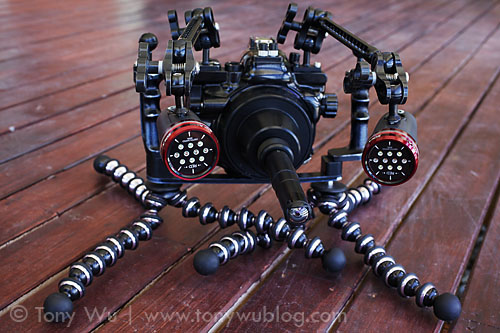If you're an underwater photographer, you may have noticed that the photos I recently posted of Barney the moray eel and the red frogfish have a somewhat unusual perspective.
I took the photos with a new insect-eye lens.
By way of background…the purpose of an insect-eye lens is to allow you to take wide-angle photographs from the vantage point of a very small animal, such as an insect. Some people call it a bug-eye lens, or a WAM lens (short for wide-angle macro).
Whatever your choice of nomenclature, the concept isn't new. People have been using lenses like this for many years, especially for land photography.
The use of insect-eye lenses in underwater photography has been less prevalent however, probably because major lens manufacturers don't make such lenses, which means they're not readily available.
In addition, designing and making an insect eye lens with good optics is complicated and costs a lot of money, which is always a bit of a bummer.
And finally, assuming you actually make a decent insect-eye lens, you then have to waterproof it! What a hassle.
In recent months, several of my friends have been using the insect-eye lens manufactured by Inon and have been producing some really interesting images and video.
This of course made me really anxious to test the new lens pictured below:

The Totomega insect eye lens with my Canon 7D camera
in a Zillion housing + two SOLA 600 lights for lighting
The lens is made by a photographer friend of mine in Japan, who calls his creation the Totomega lens. It's a self-enclosed relay lens that fits on to a custom-built port, which houses a lens attached to an APS sensor camera...in my case, a Canon EOS 7D. The main lens is a 28-80mm Sigma lens, stacked on a 1.4x teleconverter.
When all is said and done, the resulting field of view underwater is somewhere in the 160-degree range.
Shooting with this type of lens is unlike anything I've tried before. Given that it's my first experience with the lens and that there aren't exactly a lot of people I can ask for advice, it took me a few dives to figure out how to use the Totomega.
Autofocus works like a charm, with one significant catch: The actual focus isn't where the camera's focus point locks on, meaning I have to adjust the camera position to take into account the differential in what the camera thinks is in focus and what actually is in focus.
The method I've developed to deal with this conundrum is to estimate the lens-to-subject distance for the point I want to be in focus, estimate a distance of approximately 1+ cm closer than my desired focus, AF lock at that distance, then reposition to my actual desired focus distance and shoot, keeping in mind that my desired focus distance usually means lens-to-critter-eye distance, not simply lens-to-critter distance.
Sound complicated?
It is.
I'm sure you can see why it took me a bit of trial-and-error over several dives (accompanied by considerable muttering under my breath) until I figured out a system that works. At this point, I can nail a significant proportion of the shots I try.
Two people on the Ambon Night Safari trip, Eric Cheng and Julian Cohen, had Inon lenses with them, so we inevitably traded notes and compared images. Here's what we concluded (Eric, Julian: please correct me if I mis-stated or forgot something):
1. The Inon lens requires manual focus. The Totomega uses AF, but the AF position is not where it seems (or at least, I haven't yet been able to get the actual AF to be where the AF point locks).
2. The Inon lens can focus right up to the lens surface. The Totomega can focus to about 1cm away from the lens surface.
3. The Inon lens can make really small things look big in the frame. Eric came up with the best description for the Totomega's optical characteristics. In his words: "It makes big things look like small things made to look big." I love that description.
4. When both lenses are at their sharpest, the Totomega lens is sharper than the Inon lens.
5. Both lenses are good for shooting video.
6. Both lenses exhibit significant chromatic aberration.
The bottom line is that the two lenses were created with a similar objective, but have different optical characteristics. Both are a challenge to shoot, but the unique perspective can make the effort worthwhile.
I'm sure there are still many things I'll figure out in the next couple of weeks, and I'll have to cross-check my experience with my friend in Japan after I get back home.
I have a suspicion that there may be some way to tweak my lens set up so that I can focus more closely. I hope that's the case, so that I'll be able to use this lens for smaller subjects in the future.
Given my limited experience with the lens so far, please consider my views on the Totomega an evolving (mis)understanding, rather than a definitive description.